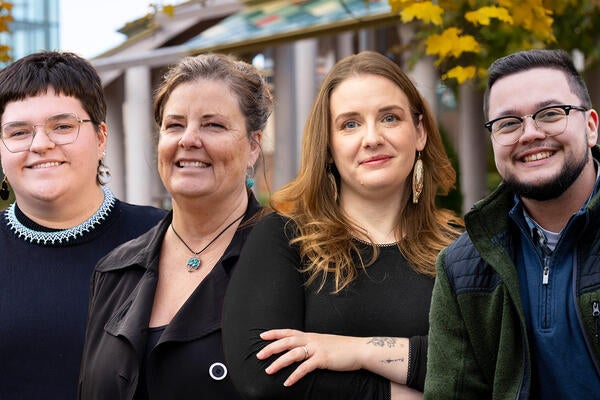
Students combine creative and professional writing in new program
The English department’s new major brings together often separated but complementary forms of writing.

The English department’s new major brings together often separated but complementary forms of writing.
By Olivia Vanderwal Faculty of Arts“We noticed in the last five to seven years a real increase in interest in creative writing courses. Students were asking for them, and our courses were always full with waitlists,” says Dr. Victoria Lamont, Associate Chair of Undergraduate Studies. Given the increased demand, the department of English Language and Literature is launching a new major this fall in Creative and Professional Writing (CPW). The unique program will allow students to pursue a broad range of writing genres, including fiction, drama, graphic narratives, business communication, editing and digital design.
“[The program] was sort of a perfect storm of different things,” Lamont notes. With growing interest from students and the ongoing popularity of the creative writing specialization and diploma offering, a more robust program felt like a natural progression.
At the same time, faculty members in the English department were becoming published creative writers, now boasting an impressive list of achievements and specializations. Dr. Sarah Tolmie began writing novels and poetry inspired by her work as a Medievalist, and her poetry collection The Art of Dying was shortlisted for The Griffin Poetry Prize. Dr. Jennifer Harris published her first children’s picture book and now has a multi-book deal. Lecturer and alumna Carry Snyder was a Rogers Writers’ Trust Prize and a Governor General’s Award finalist for her fiction. Dr. Lamees Al Ethari published a memoir and continues to mentor women who are writers and immigrants through The X Page. And that’s just to name a few.
“Students who earn the CPW will acquire more than just strong writing skills – their writing will be animated by their distinct voice and creative energy, which will not only prepare them for the job market but set them apart.”
Another factor was the English department at St. Jerome’s University and their longstanding history of teaching creative writing. In addition to working regularly with creative writers in the community, St. Jerome’s also hosts a reading series that brings Canadian writers to campus and is home to the literary journal The New Quarterly. “[Our partnership with them] was really important in us knowing that we could introduce a new major and have the support behind it,” notes Lamont.
This combination of student interest, faculty talent and organizational support led to three years of research, development, negotiation and approvals to launch the new major. “A lot of people had to come together for this to happen,” adds Lamont.
During her initial research into creative writing programs, Lamont was surprised by the lack of programs in Canada that linked creative and professional writing. “It struck me as a bit odd because I don't think it's a total myth that it takes a long time to get established as a creative writer,” she says. “And so what do you do in the meantime? How do you feed yourself?”
In conversations with writers and students, Lamont and her colleagues also kept hearing about the importance of creative writers being able to negotiate with publishers and market themselves; on the other hand, they heard about technical writers and advertisers drawing on creative approaches. “When I teach professional writing courses, creative writing principles are always part of the conversation,” says Dr. Andrea Jonahs, a lecturer who holds an MFA in Nonfiction Writing. “The ability to tell stories, create word pictures, and stir emotion, for example, are necessary for persuasive communication. Likewise, in my creative writing classes students create art, but their creative impulses must still be attentive to their audience.”
The Creative and Professional Writing major aims to bring these often separated but complementary modalities together in order to train students to be skilled, well-rounded and agile writers. “It speaks to a nexus that is highly valued,” Jonahs notes. “Students who earn the CPW will acquire more than just strong writing skills – their writing will be animated by their distinct voice and creative energy, which will not only prepare them for the job market but set them apart.”

Read more
New executive program with Waterloo Region Health Network helps health care executives navigate ongoing AI transformation

Read more
Researchers awarded funding to investigate ecology, climate change, repatriation, health and well-being through cultural and historical lens

Read more
Professor launches Canada’s first large-scale VR use in the classroom, embracing emerging technology and driving the future of education
The University of Waterloo acknowledges that much of our work takes place on the traditional territory of the Neutral, Anishinaabeg, and Haudenosaunee peoples. Our main campus is situated on the Haldimand Tract, the land granted to the Six Nations that includes six miles on each side of the Grand River. Our active work toward reconciliation takes place across our campuses through research, learning, teaching, and community building, and is co-ordinated within the Office of Indigenous Relations.